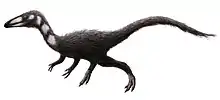Löwenstein Formation
The Löwenstein Formation (Stubensandstein in Baden-Württemberg, Burgsandstein in Bavaria) is a lithostratigraphic formation of the Keuper in Germany. It is underlain by the Mainhardt Formation and overlain by the Trossingen Formation. It dates back to the middle Norian.[1]
| Löwenstein Formation Stratigraphic range: Mid Norian (Alaunian) 215.6–212 Ma | |
|---|---|
| Type | Geological formation |
| Unit of | Keuper |
| Underlies | Trossingen Formation |
| Overlies | Mainhardt Formation |
| Thickness | At least 80 m |
| Lithology | |
| Primary | Sandstone |
| Other | Marl |
| Location | |
| Region | Europe |
| Country | |
| Extent | Bavaria, Baden-Württemberg |
Vertebrate fauna
- Ceratodus elegans Vollrath, 1923, a lungfish from the Stubensandstein[2]
Archosaurs
Theropod tracks and an unnamed herrerasaur genus are known from the Lower Stubensandstein.[3]
| Archosaurs of the Stubensandstein | ||||||
|---|---|---|---|---|---|---|
| Genus | Species | Location | Stratigraphic position | Material | Notes | Images |
| Dolichosuchus[4] | D. cristatus[4] | Middle[4] | "Tibia"[5] | Actually indeterminate coelophysoid remains[4] | ||
| Halticosaurus[4] | H. longotarsus[4] | Middle[4] | "Mandibular fragment, vertebrae, humerus, illium, femur, metatarsal."[5] | Later found to be indeterminate coelophysoid remains[4] | ||
| Plateosaurus[6] | P. gracilis[6] | "[Twenty one] partial skeletons, isolated elements, [three] partial skulls, juvenile to adult."[7] | Yates assigned the type material of Sellosaurus gracilis to Plateosaurus gracilis [8] | |||
| P. trossingensis | Type species. | |||||
| Procompsognathus[4] | P. triassicus[4] | Middle[4] | "Partial postcranial skeleton."[9] |  | ||
| Teratosaurus[4] | T. minor[4] | Middle[4] | Galton and Benton showed that Teratosaurus is actually a rauisuchian.[10][11] |  | ||
| T. trossingensis[4] | Middle[4] | Galton and Benton showed that Teratosaurus is actually a rauisuchian.[10][11] | ||||
Color key
|
Notes Uncertain or tentative taxa are in small text; |
See also
- List of dinosaur-bearing rock formations
- List of fossiliferous stratigraphic units in Germany
- List of fossiliferous stratigraphic units in Switzerland
References
- Weishampel, David B; et al. (2004). "Dinosaur distribution (Late Triassic, Europe)." In: Weishampel, David B.; Dodson, Peter; and Osmólska, Halszka (eds.): The Dinosauria, 2nd, Berkeley: University of California Press. Pp. 521–525. ISBN 0-520-24209-2.
- Ceratodus elegans n. sp. aus dem Stubensandstein. P Vollrath, Jahresberichte und Mitteilungen des Oberrheinischen Geologischen Vereins, 1923
- "17.2 Baden-Württemberg, Germany; 1. Lower Stubensandstein," in Weishampel, et al. (2004). Page 524.
- "17.2 Baden-Württemberg, Germany; 2. Middle Stubensandstein," in Weishampel, et al. (2004). Page 524.
- "Table 3.1," in Weishampel, et al. (2004). Page 50.
- "17.2 Baden-Württemberg, Germany; '1. Lower Stubensandstein' and '2. Middle Stubensandstein,'" in Weishampel, et al. (2004). Page 524.
- "Table 12.1," in Weishampel, et al. (2004). Page 236.
- Yates, A.M. (2003). "Species taxonomy of the sauropodomorph dinosaurs from the Löwenstein Formation (Norian, Late Triassic) of Germany". Palaeontology 46 (2): 317–337
- "Table 3.1," in Weishampel, et al. (2004). Page 48.
- Galton, P. M. (1985). "The poposaurid thecodontian Teratosaurus suevicus von Meyer, plus referred specimens mostly based on prosauropod dinosaurs". Stuttgarter Beiträge zur Naturkunde, B, 116: 1-29.
- Benton, M.J. (1986). "The late Triassic reptile Teratosaurus - a rauisuchian, not a dinosaur". Palaeontology 29: 293-301.
Bibliography
- Weishampel, David B.; Peter Dodson, and Halszka Osmólska (eds.). 2004. The Dinosauria, 2nd edition, 1–880. Berkeley: University of California Press. Accessed 2019-02-21. ISBN 0-520-24209-2
This article is issued from Wikipedia. The text is licensed under Creative Commons - Attribution - Sharealike. Additional terms may apply for the media files.